Discover Croatia close up. TCN's 25 Things to Know series continues on February 15, 2016, with a look at a city famous for its beer, but with plenty more to offer the visiting tourist - Karlovac.
1. “The City on four rivers”.

(The confluence of Korana and Kupa | pic. Hostel Na putu)
I should begin really with the four most important feature(s) of the city. Karlovac is known by a few different nicknames. The most commonly used of them refers to its location on the confluence of the rivers Kupa, Korana, Mrežnica and Dobra. Essentially tributaries of the Danube, the River Korana (which rises in Plitvice Lakes National Park) joins with Mrežnica 4km south of Karlovac city centre at the suburb village of Turanj. The River Dobra joins with Kupa (the largest of them all) to the north. Korana then joins Kupa to the East (phew, a lot of “joining”!). Historically these waterways served to aid in the defence of the town and due to links with the Danube via the Sava it would make the town a very important trading centre.
2. Zvijezda – “the star”.
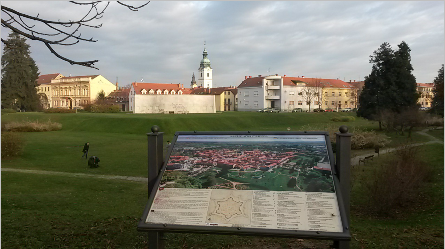
(The “Star” | pic. Hostel Na putu)
The city Karlovac began life as a fortress town built totally from scratch as part of a defensive network of castles and forts that stretched from Senj on the Adriatic to Đurđevac near today’s Hungarian border.
In the 16th century, this region was part of the Habsburg Empire and governed from Vienna. Constantly knocking on the door down south was the Ottoman Empire. Their persistent and increasingly productive invasions were becoming problematic for the Emperor Ferdinand I. He finally said “enough!” and came up with the plan to establish a militarised buffer zone on his southern borders. Archduke of Austria - Charles II (“Karl” in German) struck a deal for financing the construction and decided the fortress should naturally be named after him. “Karlstadt” in German. “Charlestown” in English. “Karlovac” in Croatian.
The fortress was designed in the shape of a six-pointed star. It bore all the features of what was perceived to be the “ideal renaissance city” and really excited the planning nerds of the period throughout Europe. The inner core of military buildings, shops and dwellings were nicely organised in a grid around a central square. This of course had to be fortified and was surrounded by six bastions connected by high compacted dirt embankments and an outer network of excavated moats.
3. Karlovac has a birthday!

(Birthday celebrations on the main square | pic. Karlovac tourist office.)
Something rare for a city is that the exact date construction works started on the fortress is recorded as the 13th July 1579. This date is celebrated every year as the “Birthday of Karlovac” or “Dan grada Karlovca”. Celebrations start in late June. The weeks leading up to the big day are full of events in the city culminating with the traditional “birthday ball” on the main square. This is where 400 couples come and have a waltz. Anyone can join in but you and your partner must sign up beforehand for your “spot” on the square via the city website. The evening ends with a concert that continues well into the night.
4. Karlovačko Beer is brewed here. Duh!!
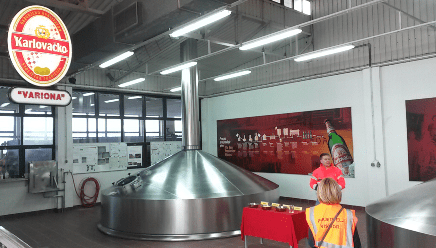
(The “fifth river” brewery tour | pic. Hostel Na putu)
In Karlovac; if someone invites you to “go for a coffee” more often than not that implies “let’s go for a beer”. Another of the city’s nicknames should actually be “the city of beer”! As an Irish person (playing on our alcoholic stereotype as a nation) this pleases me. Subliminally it is probably why I ended up living here now that I think of it…
One of the two most popular brands of beer in the country has been brewed by Karlovačka pivovara (Karlovac Brewery) since it was founded by local landowner Baron Nikola Vranyczany-Dobrinovic in 1854.
5. Surprise-surprise - Karlovac also has a beer festival.
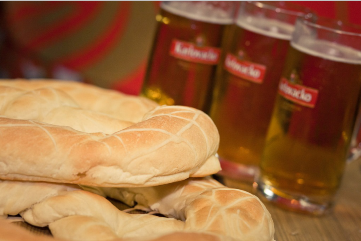
(Dani Piva | pic. Karlovac tourist office.)
Since 1984; Karlovačko “Days of Beer” (Dani piva) festival is an annual ten-day celebration of beer. They say beer flows as the fifth river on these ten days. I guess you could call it “Croatia’s Oktoberfest”…but held in August – AugCroberfest! I get stick from locals for making the comparison but the similarities are there for all to see.
It’s the biggest beer festival in the country. You have big tents with benches. People enjoying local foods listening to local music, singing and drunken-ness. Not to mention the MILES of sausage and stacks of giant pretzels. They also brew a special non-pasteurised “Fest-Beer” and of course, there is a fairground. The day’s music schedule climaxes with a different genre of band or singer each night. Include the fact we still have thirsty summer weather in August and it all adds up to a good time if you ask me - AUGCROBERFEST!
6. Michael Jackson shot a music video here.
Everyone remembers MJ right? The video for his single; “Earth Song”, was released in 1995 and was shot in four locations around the globe. It dealt with subjects of environment and animal welfare with scenes of illegal poaching, destruction of the rainforest and war. The war scenes were shot here.
Karlovac was on the frontline in the Homeland War from 1991-95 and was severely damaged as a result. The location used in the video was the suburb of Turanj which was practically levelled over the four years of fighting.
7. The first music school in Croatia was in Karlovac.
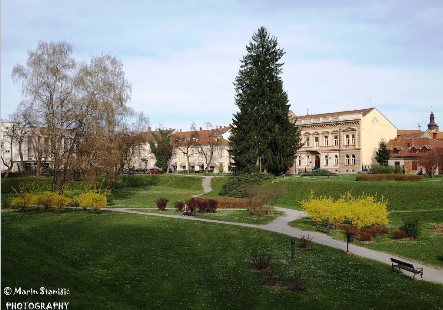
(Karlovac music school | pic. Marin Stanišić.)
Yes, music was taught in other cities as part of various educational institutions’ curricula but the first independent school for music in the country was established here on 10th October 1804. It is actually one of the oldest in the Balkan region.
The first music teacher was Franc Zihak and he had 17 pupils. Nowadays it has around 500 pupils and hosts the annual Karlovac International Piano festival each summer.
The school is now located in a beautiful neo-renaissance palace built in 1890 within Zvijezda.
8. The Croatian Homeland War Museum.
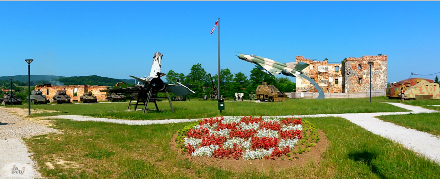
(The Homeland War Museum | pic. Hostel Na putu.)
This open-air exhibition was established in 2003 by a former Croatian Army officer to both mark the significance of this area and the sacrifice of the local people. It is located in the village of Turanj on the site of a ruined Austro-Hungarian military facility.
Turanj has been associated with the defence of Karlovac since an outpost was positioned here in 1582 to defend the southern crossing of the river Mrežnica. The village also played its part in bearing the brunt of fighting during the Homeland War (1991-95).
Displayed in the museum is a collection of weapons used by the Croatian Army during this time.
9. Karlovac was the capital of Croatia.
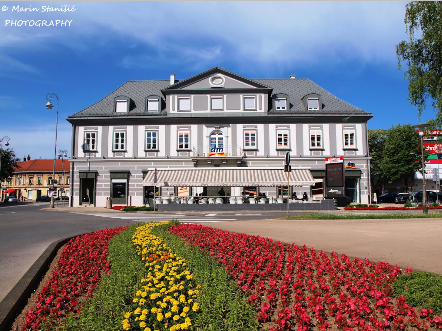
(Žitna kuća, one of the first brick buildings built outside of Zvijezda | pic. Marin Stanišić.)
Well, almost. In the early 19th century Napoleon conquered the areas roughly encompassing what is now Slovenia, Istria, the Karlovac-Lika region and the Adriatic coast all the way to Dubrovnik. He incorporated it into his French Empire as an Autonomous region called the Illyrian Provinces. The Provinces were divided into eleven departments and Karlovac (which was already the military command of Habsburg Croatia) was named “capital” of the Croatian department.
The town had only in 1781 been granted “free royal city” status by the Emperor Joseph II. The Treaty of Karlowitz shifted the Ottoman borders further south so military restrictions preventing the expansion of the city beyond the fortifications were relaxed. Enter: Napoleon, with his fancy French modern thinking!
Even though French rule was short-lived (1809-16) it made a significant impact on society. Civil law was modernised and successes of the French revolution were introduced to the people. Infrastructure around the city was upgraded and the city was catapulted into a “golden age” of great wealth, development and culture.
10. “City of Meetings”…

(The marker signalling the beginning of the Carolina and Louisiana Roads | pic. Marin Stanišić.)
Geographically speaking, Karlovac is the meeting point of a lot of things. This little town on the edge of two Empires was well known for its struggles as part of the “bulwark of Christianity”. Six kilometres into the earth the Dinarides and Pannonian basin tectonic plates come together. We already know that four rivers meet here on their way to the Danube.
The town’s importance to the Habsburg Empire and Napoleon’s Illyrian Provinces meant that they built new modern roads connecting their northern Adriatic ports to the city. Three of the most important roads built in the 18th and 19th centuries all converged on Karlovac: The Josefina, Carolina and Louisiana. The Karlovac-Rijeka Louisiana road was finished by the French in 1809 and it was one of the most modern roads in Europe of the time.
11. Kamensko was an ancient Roman river port.

(The Pauline Monastery at Kamensko | pic. Marin Stanišić.)
Last year a sunken ship on the bed of the River Kupa near the suburb village Kamensko was identified to be Roman. It is thought that it dates from the late 1st century when this part of Croatia was the Provence of Pannonia. The boat is well preserved in the mud and was carrying a cargo of bricks at the time it sank that are still neatly stacked. It is already known that several Roman quarries were located around Karlovac and it is believed that the Kupa was used to transport materials to Roman towns further downstream such as Siscia (Sisak).
12. Nikola Tesla attended school in Karlovac.
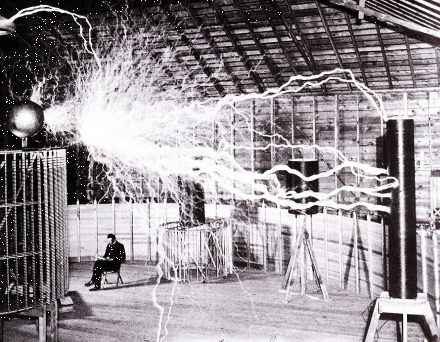
Nikola Tesla: genius and inventor who gave the world alternating electrical current (AC), the electric motor (power tools, household appliances, disk-drives…), x-ray, wireless communications (radio, internet, remote-control devices…) and sought to provide free energy to the world was born near Gospić in 1856. A full list of his patents is here.
At the age of 14 he was sent to attend State secondary school in Rakovac (now Gimnazija Karlovac). He completed a four year course in three years with honours. It was there that young Tesla was inspired to follow the path of electrical engineer by the experiments and demonstrations of his physics professor; Martin Sekulić.
“I was very interested in electricity; the influence of my physics professor, who was an ingenious man and often demonstrated the basic laws with devices that I invented…I cannot express my excitement when I was present at his experiments…Every impression produced a thousand echoes in my brain. I'm on a mission to find out more; I longed for experiment and investigation…”
-Nikola Tesla. “My inventions”.
13. The last and most famous wedding (very “Game of Thrones”!).
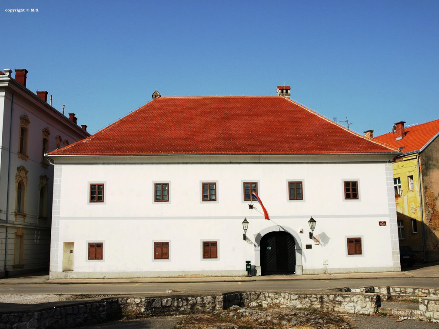
(Former house of General Vuk Kristo Frankopan , now Karlovac City Museum | pic. Marin Stanišić.)
For those of you who are not familiar with the Frankopan and Zrinski names; they were two extremely powerful, wealthy and influential aristocratic families in Croatia whose bloodlines extend back to the 12th (House of Frankopan) and 14th (House of Zrinski) centuries respectively.
The wedding party (in 1641) in question happened in Karlovac and Ozalj and was between two sweethearts of Croatian history: Petar Zrinski (Ban and poet) and Ana Katarina Frankopan (also a poet and a patron of the arts), daughter of General Vuk Kristo Frankopan. It was to be the last of either family.
The joining of the houses set in motion an attempted coup called the Zrinski-Frankopan conspiracy. The families set to overthrow the Habsburg monarchy. The plan was to rid Croatia and Hungary of outside influence once and for all by secretly gaining international support for their rebellion. The revolt was badly planned and ultimately a total disaster. Petar and Katarina’s half-brother Fran Kristo Frankopan were arrested and beheaded in Wiener Neustadt in 1671. Thousands of noblemen were subsequently arrested by order of the Emperor and their estates looted and destroyed. These executions essentially ended the bloodlines of Houses Frankopan and Zrinski. Katarina was also arrested and sentenced to exile in a convent in Graz until her death two years later.
14. Old town Dubovac.
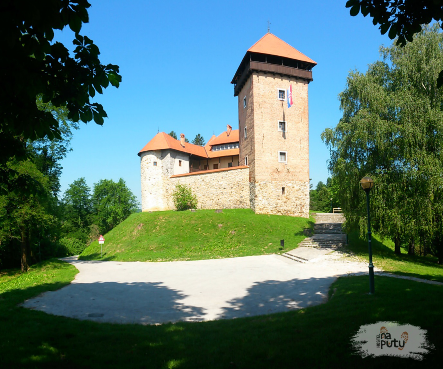
(Old town Dubovac | pic. Hostel Na putu)
The castle of Dubovac sits on an ancient hill overlooking the town. It was probably built sometime either side of the beginning of the 13th century. Over the centuries it has had numerous noble owners including the doomed Frankopan and Zrinski families. It was also the military command of Karlovac and was besieged, but never conquered by the Ottoman armies multiple times.
The castle has undergone several adaptations and facelifts. Even an Irishman has had a hand in its design. Count Laval Nugent von Westmeath is credited with its current look from the late 18th century but all the most significant structural changes occurred while it belonged to the Frankopans (1442-1550).
15. Dark implications…
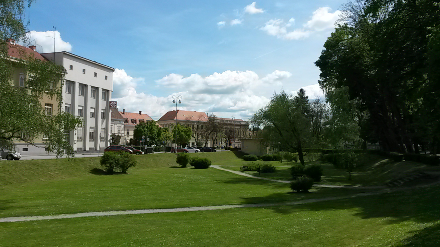
(What kind of secrets could be buried under here? | pic. Hostel Na putu.)
Croatia, like my homeland is full of myths, legends and alleged sinister goings on. Tales of witch-hunts, secret tunnels and the occult are dotted through medieval history. One particularly dark story is of the legend of the nine skulls.
It is said that the ramparts of Zvijezda (the Star-fortress) were built on the severed heads of nine Turkish soldiers. This was in revenge for their attack on Dubovac castle during Easter 1578. The Ottoman forces succeeded in burning the castle on this occasion but were defeated nonetheless. The story goes that out of fear of another beating, the Turks never attacked the builders for the duration it took them to construct the fortress.
16. Croatia’s first movie theatre.
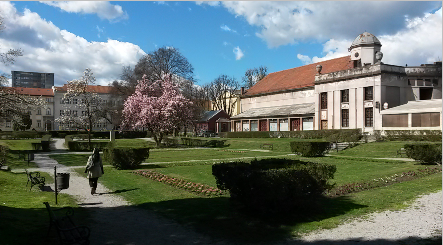
(Edison Cinema | pic. Hostel Na putu)
“Edison” (named after Thomas Eddison) was the first purpose-built cinema in Croatia. It was completed in 1920 and had seating for 490 people. Initially, it was perceived to be ambitious to have such a large theatre in a city of Karlovac’ size. Critics were proven wrong however and the theatre was full night after night.
Sadly today the theatre is in a state of identity-limbo. It is no longer used as a cinema. Instead it is a sometime café/sometime music venue. It should only make sense that this treasure should be restored to its former glory as a tribute to Croatian and International cinema.
17. Karlovac has an International Film festival.

The Youth Film Festival & Four River Film Festival is five day event held annually in Karlovac. Both events are a celebration of high-school film making. The Youth festival focuses on filmmaking at a national level while the Four Rivers version is an international event. The festival attracts around 150 students from 30 countries worldwide. More info here.
18. World famous explorers “The Brothers Seljan”.
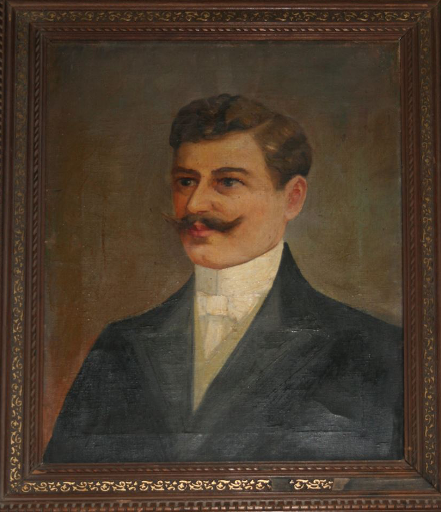
Mirko and Stjepan Seljan were born in Karlovac and attended school in here. The two bothers a best known for being the greatest explorers of their time in the late 19th and early 20th centuries.
Their travels took them through Europe and to places as far away as Africa and the Americas as they aimed to enrich people with new knowledge and understanding of the world. It is not hard to understand what ignited their passion for exploring rivers in particular when you consider where they came from!
Their contribution to the fields of Climatology, Geomorphology and Ethnography through their diaries and cultural inventory donated to the Ethnographic Museum in Zagreb has been invaluable. Sadly the fate of Mirko is not known. He disappeared on an expedition in 1913. Stjepan spent his final years in Brazil and died in 1936.
19. A base for adventure…

(River rafting | pic. Terra Croatica Outdoor Company.)
All four rivers offer their own brand of rafting or kayaking. It’s a popular daytrip for visitors to the city as there is something on offer to suit all levels of experience. Locals will say that the best rafting in the whole country is on the River Dobra. The first commercially organised rafting trips in Croatia began on this river. In early spring, the wild upper-reaches of Kupa attract the more experienced enthusiasts.
Mrežnica is a regular candidate for most beautiful river in Croatia. It cuts its course though some of the most rugged and uninhabited landscape in the country. Rafting and raft safari (at low water levels) are popular and are possible for all ages here.
The source of Korana is beautiful Plitvice Lakes National Park. Certain sections of the river are only accessible by raft which adds to its unspoilt beauty. Professionals are especially attracted to the stretch beginning at the medieval village of Rastoke where the river squeezes spectacularly through a narrow canyon. Near Karlovac you can take a more relaxing raft safari from the Korana-Mrežnica to the Korana-Kupa confluences.
20. “the City of Parks”
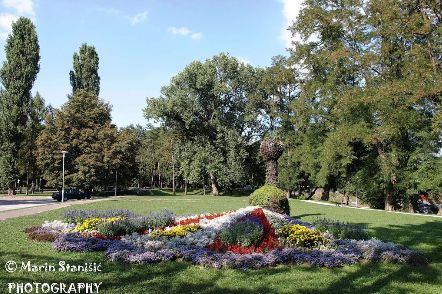
(Vrbanić Gardens | pic. Marin Stanišić.)
Another self-explanatory nickname! Karlovac truly is a city of parks. The most popular of them all is the city promenade. As the city lost its defensive worth in the 19th century and prospered, the ramparts were demolished to allow for further expansion. The City development office was founded in 1886 and their first order of business was to convert the drained ditches into parks and to plant rows of linden and chestnut trees along the outer rim of the star. This is the promenade which encircles the old city today.
Another development in 1897 was the 4.32ha Vrbanić gardens on the left bank of the river Korana. It is an open English/French style botanical garden named after then Mayor; Josip Vrbanić. The whole area surrounding the old city plus either side of Korana is practically one huge park and even the newer parts of the city are punctuated with nice open green spaces.
21. Most cycle-able city in Croatia.
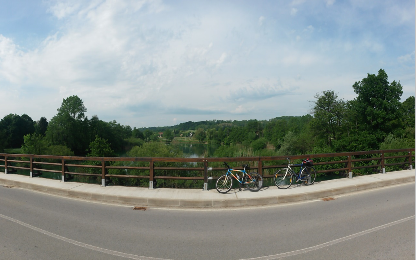
(
Cycling next to Mrežnica | pic. Hostel Na putu.)
Karlovac was awarded the title in 2014 judged on how the city administration has encouraged cycling in the previous years. In 2015 the city got its own public bike-share system. There are almost 39km of cycle paths within the city which has had legislation for cyclists since 1895.
“Bicycles must have bells and lamps. In addition, when cycling, bicyclists must have a small trumpet with them with which they can warn passers-by and carriage owners of any danger”
-Town ordinance on riding bicycles of 1895.
The beauty of Karlovac is not just limited to the urban area. In 10 minutes you can be cycling on peaceful country roads next to a river, through a forest or on your way to explore a medieval castle. There also are many beautiful swimming areas on Dobra, Korana and Mrežnica but don’t forget your trumpet and watch out for carriages!
22. An award winning beach??

(Foginovo | pic. Hostel Na putu.)
It had always been believed by locals that the River Korana has healing properties. However, it took a fellow called Dragutin Fogin Jr. in 1928 to come up with the idea of converting the wild overgrown left side riverbank into Karlovac’s very own “resort” just a 10 minute walk from the city centre!
“Foginovo” bathing area is the only registered river beach in the country and the only one that caters for the disabled. It has won the national Green Flower and Tourist Flower awards for quality as well as the annual local Karlovačko Best Beach award.
Probably the most noticeable feature of the beach is the 10m diving platform. Other recreational facilities are there for activities such as: water polo, beach volleyball, table-tennis, basketball, bowls, an outdoor gym and running track. Sport, music and dance events are often held there too.
23. KAquarium is on the way...
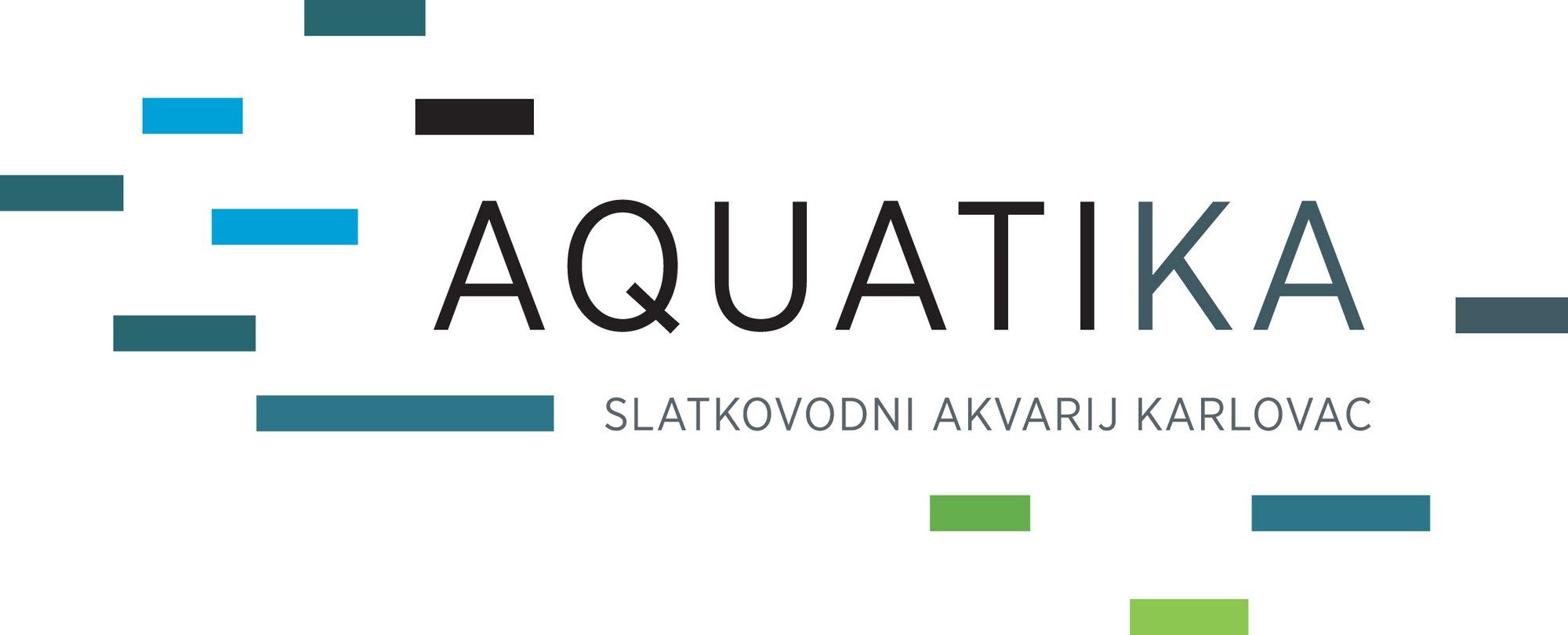
Although currently a construction site; the very first freshwater aquarium and river museum in Croatia will open in Karlovac this year.
It will be located on the right bank of the River Korana and will be partially subterranean - stealthily landscaped with the river bank. Inside visitors will find some 150 species of fish arranged in tank exhibits displaying different wetland habitats and river scenes that can be found in Croatia.
24. Ivanjski krijes – Karlovac’ oldest festival.
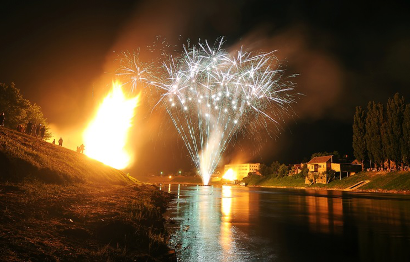
(Ivanjski krijes – Karlovac’ oldest festival | Karlovac tourist office.)
Since 1776, Ivanjski krijes (St. John’s bonfires) is celebrated on 23rd of June or mid-summers eve every year. Traditionally, the lighting of a big bonfire was intended to ward away evil spirits who could roam freely around the time of the summer solstice.
Every year in Karlovac the neighbourhoods of Banija and Gaza battle it out to see who can build the biggest bonfire. If that wasn’t enough, the two neighbourhoods also face off in a tug-o-war on the Kupa Bridge. When the time arrives, the Dubovac archers shoot flaming arrows over the river and a cannon fires signalling for the bonfires to be lit. The evening finishes with a fireworks display and concert.
25. Most important thing of all…

When I first arrived in Zagreb the one thing that really appealed to me was the pace of life there. For a European capital city; it sure didn’t feel like you were in one. It was exactly what I was looking for. Then my wife and I moved to Karlovac. Now Zagreb is too fast-paced and stressful for us!
One of the most important things we try to imprint on to our guests at our hostel is that they should forget about their plans and pressures and silly schedules if they are going to fully enjoy Karlovac. Here you can do a whole bunch of nothing and still feel fulfilled at the end of the day. You just need to be prepared to allow yourself to take a breather. Sit in a park, take an easy bike ride to some secluded waterfall, walk in the woods, drink coffee for 6 hours…relax. Locals certainly know how to, and who would blame them given the surroundings they grew up in.
I was once told - “you’ve got to slow down, because you’ll look suspicious if you walk too fast”.
Learn more about the Karlovac region in the official tourist board video below.


